氟马泽尼
- 格式:doc
- 大小:165.00 KB
- 文档页数:3
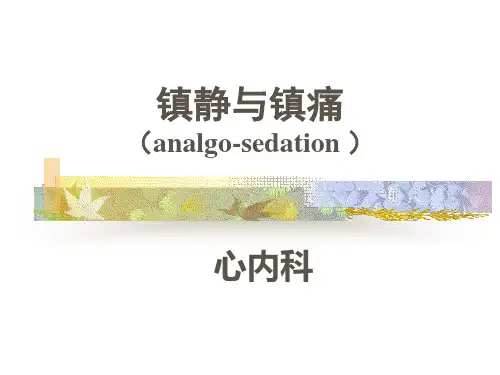

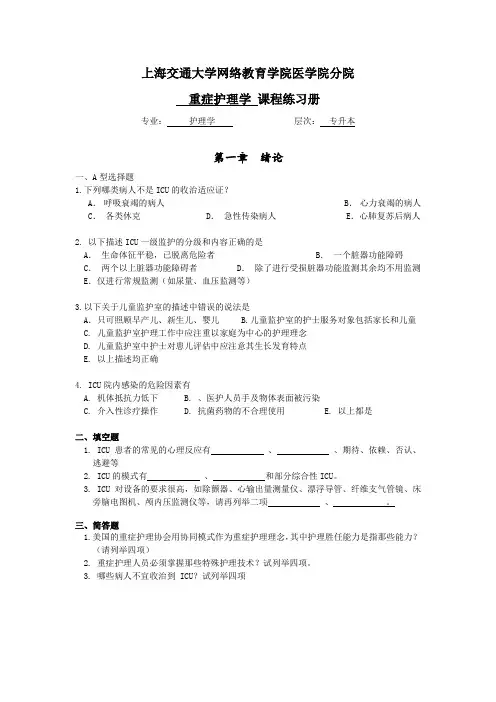
上海交通大学网络教育学院医学院分院重症护理学课程练习册专业:护理学层次:专升本第一章绪论一、A型选择题1.下列哪类病人不是ICU的收治适应证?A.呼吸衰竭的病人 B.心力衰竭的病人 C.各类休克 D.急性传染病人 E.心肺复苏后病人2. 以下描述ICU一级监护的分级和内容正确的是A.生命体征平稳,已脱离危险者 B.一个脏器功能障碍C.两个以上脏器功能障碍者 D.除了进行受损脏器功能监测其余均不用监测E.仅进行常规监测(如尿量、血压监测等)3.以下关于儿童监护室的描述中错误的说法是A.只可照顾早产儿、新生儿、婴儿 B.儿童监护室的护士服务对象包括家长和儿童C. 儿童监护室护理工作中应注重以家庭为中心的护理理念D. 儿童监护室中护士对患儿评估中应注意其生长发育特点E. 以上描述均正确4. ICU院内感染的危险因素有A. 机体抵抗力低下B. 、医护人员手及物体表面被污染C. 介入性诊疗操作D. 抗菌药物的不合理使用E. 以上都是二、填空题1. ICU患者的常见的心理反应有、、期待、依赖、否认、逃避等2. ICU的模式有、和部分综合性ICU。
3. ICU对设备的要求很高,如除颤器、心输出量测量仪、漂浮导管、纤维支气管镜、床旁脑电图机、颅内压监测仪等,请再列举二项、。
三、简答题1.美国的重症护理协会用协同模式作为重症护理理念,其中护理胜任能力是指那些能力?(请列举四项)2. 重症护理人员必须掌握那些特殊护理技术?试列举四项。
3. 哪些病人不宜收治到 ICU?试列举四项第二章危重症患者姑息期护理与家属支持一、填空题1.危重症患者姑息期心理反应的分期为:、、、‘和。
2. 1988年9月,我国创办了第一家临终关怀医院——。
3. 影响ICU患者心理健康的因素患者的年龄、生长发展阶段、过去疾病经验以及、、。
二、选择题1.被誉为“点燃了临终关怀运动灯塔”的临终关怀机构是:A美国新港临终关怀病院B西欧修道院C英国圣·克里斯多弗临终关怀医院D加拿大姑息护理协会E天津医学院临终关怀研究中心2.1988年7月,中国成立第一个临终关怀研究机构在:A南汇护理院B北京松堂医院C复旦大学医学院D汕头大学医学院第一附属医院E天津医学院3.对危重症患者及家属而言,重症监护室的住院经验往往难以承受,医护人员在此过程中,能提供的支持包括:A 心理、生理、社会支持B 心理、生理、经济支持C 心理、经济、社会支持D 生理、经济、社会支持E 生理、经济、感情支持4.面对哀伤的ICU家属,护士需要指导家属采取较积极的方法来处理,如采取,进行,提供确认及支持等。

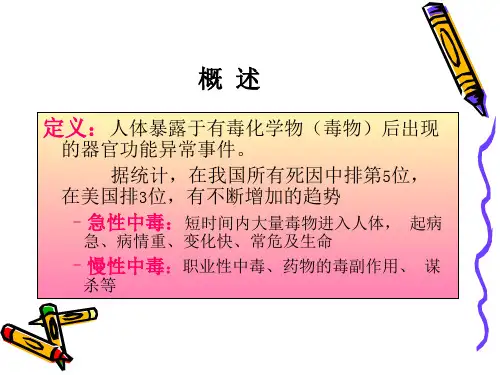
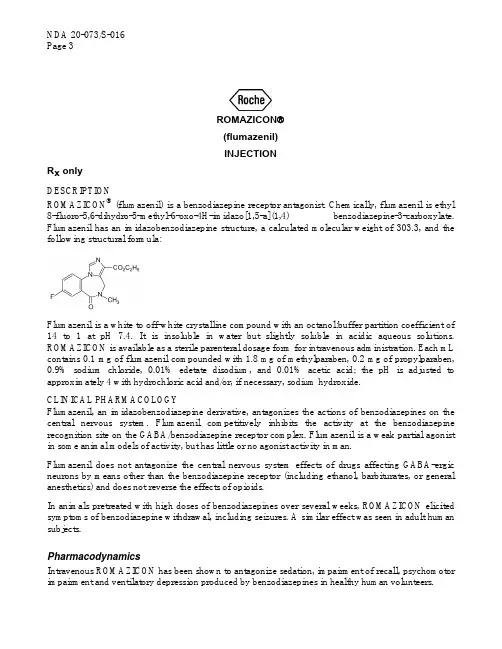
ROMAZICON®(flumazenil)INJECTIONR x onlyDESCRIPTIONROMAZICON® (flumazenil) is a benzodiazepine receptor antagonist. Chemically, flumazenil is ethyl8-fluoro-5,6-dihydro-5-methyl-6-oxo-4H-imidazo[1,5-a](1,4) benzodiazepine-3-carboxylate. Flumazenil has an imidazobenzodiazepine structure, a calculated molecular weight of 303.3, and the following structural formula:Flumazenil is a white to off-white crystalline compound with an octanol:buffer partition coefficient of14 to 1 at pH 7.4. It is insoluble in water but slightly soluble in acidic aqueous solutions. ROMAZICON is available as a sterile parenteral dosage form for intravenous administration. Each mL contains 0.1 mg of flumazenil compounded with 1.8 mg of methylparaben, 0.2 mg of propylparaben,0.9% sodium chloride, 0.01% edetate disodium, and 0.01% acetic acid; the pH is adjusted to approximately 4 with hydrochloric acid and/or, if necessary, sodium hydroxide.CLINICAL PHARMACOLOGYFlumazenil, an imidazobenzodiazepine derivative, antagonizes the actions of benzodiazepines on thecentral nervous system. Flumazenil competitively inhibits the activity at the benzodiazepine recognition site on the GABA/benzodiazepine receptor complex. Flumazenil is a weak partial agonistin some animal models of activity, but has little or no agonist activity in man.Flumazenil does not antagonize the central nervous system effects of drugs affecting GABA-ergic neurons by means other than the benzodiazepine receptor (including ethanol, barbiturates, or general anesthetics) and does not reverse the effects of opioids.In animals pretreated with high doses of benzodiazepines over several weeks, ROMAZICON elicited symptoms of benzodiazepine withdrawal, including seizures. A similar effect was seen in adult human subjects.PharmacodynamicsIntravenous ROMAZICON has been shown to antagonize sedation, impairment of recall, psychomotor impairment and ventilatory depression produced by benzodiazepines in healthy human volunteers.The duration and degree of reversal of sedative benzodiazepine effects are related to the dose and plasma concentrations of flumazenil as shown in the following data from a study in normal volunteers.Generally, doses of approximately 0.1 mg to 0.2 mg (corresponding to peak plasma levels of 3 to 6 ng/mL) produce partial antagonism, whereas higher doses of 0.4 to 1 mg (peak plasma levels of 12 to 28 ng/mL) usually produce complete antagonism in patients who have received the usual sedating doses of benzodiazepines. The onset of reversal is usually evident within 1 to 2 minutes after the injection is completed. Eighty percent response will be reached within 3 minutes, with the peak effect occurring at 6 to 10 minutes. The duration and degree of reversal are related to the plasma concentration of the sedating benzodiazepine as well as the dose of ROMAZICON given.In healthy volunteers, ROMAZICON did not alter intraocular pressure when given alone and reversed the decrease in intraocular pressure seen after administration of midazolam.PharmacokineticsAfter IV administration, plasma concentrations of flumazenil follow a two-exponential decay model. The pharmacokinetics of flumazenil are dose-proportional up to 100 mg.DistributionFlumazenil is extensively distributed in the extravascular space with an initial distribution half-life of 4 to 11 minutes and a terminal half-life of 40 to 80 minutes. Peak concentrations of flumazenil are proportional to dose, with an apparent initial volume of distribution of 0.5 L/kg. The volume of distribution at steady-state is 0.9 to 1.1 L/kg. Flumazenil is a weak lipophilic base. Protein binding is approximately 50% and the drug shows no preferential partitioning into red blood cells. Albumin accounts for two thirds of plasma protein binding.MetabolismFlumazenil is completely (99%) metabolized. Very little unchanged flumazenil (<1%) is found in the urine. The major metabolites of flumazenil identified in urine are the de-ethylated free acid and its glucuronide conjugate. In preclinical studies there was no evidence of pharmacologic activity exhibited by the de-ethylated free acid.EliminationElimination of radiolabeled drug is essentially complete within 72 hours, with 90% to 95% of the radioactivity appearing in urine and 5% to 10% in the feces. Clearance of flumazenil occurs primarilyby hepatic metabolism and is dependent on hepatic blood flow. In pharmacokinetic studies of normal volunteers, total clearance ranged from 0.8 to 1.0 L/hr/kg.Pharmacokinetic parameters following a 5-minute infusion of a total of 1 mg of ROMAZICON mean (coefficient of variation, range):C max (ng/mL) 24 (38%, 11-43)AUC (ng·hr/mL) 15 (22%, 10-22)0.8-1.6)V ss (L/kg) 1 (24%,Cl (L/hr/kg) 1 (20%, 0.7-1.4)Half-life (min) 54 (21%, 41-79)Food Effects:Ingestion of food during an intravenous infusion of the drug results in a 50% increase in clearance, most likely due to the increased hepatic blood flow that accompanies a meal.Special PopulationsThe ElderlyThe pharmacokinetics of flumazenil are not significantly altered in the elderly.GenderThe pharmacokinetics of flumazenil are not different in male and female subjects.Renal Failure (creatinine clearance <10 mL/min) and HemodialysisThe pharmacokinetics of flumazenil are not significantly affected.Patients With Liver DysfunctionFor patients with moderate liver dysfunction, their mean total clearance is decreased to 40% to 60% and in patients with severe liver dysfunction, it is decreased to 25% of normal value, compared with age-matched healthy subjects. This results in a prolongation of the half-life to 1.3 hours in patients with moderate hepatic impairment and 2.4 hours in severely impaired patients. Caution should be exercised with initial and/or repeated dosing to patients with liver disease.Drug-Drug Interaction:The pharmacokinetic profile of flumazenil is unaltered in the presence of benzodiazepine agonists and the kinetic profiles of those benzodiazepines studied (ie, diazepam, flunitrazepam, lormetazepam, and midazolam) are unaltered by flumazenil. During the 4-hour steady-state and post infusion of ethanol, there were no pharmacokinetic interactions on ethanol mean plasma levels as compared to placebo when flumazenil doses were given intravenously (at 2.5 hours and 6 hours) nor were interactions of ethanol on the flumazenil elimination half-life found.Pharmacokinetics in Pediatric PatientsThe pharmacokinetics of flumazenil have been evaluated in 29 pediatric patients ranging in age from 1 to 17 years who had undergone minor surgical procedures. The average doses administered were 0.53 mg (0.044 mg/kg) in patients aged 1 to 5 years, 0.63 mg (0.020 mg/kg) in patients aged 6 to 12 years, and 0.8 mg (0.014 mg/kg) in patients aged 13 to 17 years. Compared to adults, the elimination half-life in pediatric patients was more variable, averaging 40 minutes (range: 20 to 75 minutes). Clearance and volume of distribution, normalized for body weight, were in the same range as those seen in adults, although more variability was seen in the pediatric patients.CLINICAL TRIALSROMAZICON has been administered in adults to reverse the effects of benzodiazepines in conscious sedation, general anesthesia, and the management of suspected benzodiazepine overdose. Limited information from uncontrolled studies in pediatric patients is available regarding the use of ROMAZICON to reverse the effects of benzodiazepines in conscious sedation only.Conscious Sedation in AdultsROMAZICON was studied in four trials in 970 patients who received an average of 30 mg diazepam or 10 mg midazolam for sedation (with or without a narcotic) in conjunction with both inpatient and outpatient diagnostic or surgical procedures. ROMAZICON was effective in reversing the sedating and psychomotor effects of the benzodiazepine; however, amnesia was less completely and less consistently reversed. In these studies, ROMAZICON was administered as an initial dose of 0.4 mg IV (two doses of 0.2 mg) with additional 0.2 mg doses as needed to achieve complete awakening, up to a maximum total dose of 1 mg.Seventy-eight percent of patients receiving flumazenil responded by becoming completely alert. Of those patients, approximately half responded to doses of 0.4 mg to 0.6 mg, while the other half responded to doses of 0.8 mg to 1 mg. Adverse effects were infrequent in patients who received 1 mg of ROMAZICON or less, although injection site pain, agitation, and anxiety did occur. Reversal of sedation was not associated with any increase in the frequency of inadequate analgesia or increase in narcotic demand in these studies. While most patients remained alert throughout the 3-hour postprocedure observation period, resedation was observed to occur in 3% to 9% of the patients, and was most common in patients who had received high doses of benzodiazepines (see PRECAUTIONS).General Anesthesia in AdultsROMAZICON was studied in four trials in 644 patients who received midazolam as an induction and/or maintenance agent in both balanced and inhalational anesthesia. Midazolam was generally administered in doses ranging from 5 mg to 80 mg, alone and/or in conjunction with muscle relaxants, nitrous oxide, regional or local anesthetics, narcotics and/or inhalational anesthetics. Flumazenil was given as an initial dose of 0.2 mg IV, with additional 0.2 mg doses as needed to reach a complete response, up to a maximum total dose of 1 mg. These doses were effective in reversing sedation and restoring psychomotor function, but did not completely restore memory as tested by picture recall. ROMAZICON was not as effective in the reversal of sedation in patients who had received multiple anesthetic agents in addition to benzodiazepines.Eighty-one percent of patients sedated with midazolam responded to flumazenil by becoming completely alert or just slightly drowsy. Of those patients, 36% responded to doses of 0.4 mg to 0.6 mg, while 64% responded to doses of 0.8 mg to 1 mg.Resedation in patients who responded to ROMAZICON occurred in 10% to 15% of patients studied and was more common with larger doses of midazolam (>20 mg), long procedures (>60 minutes) and use of neuromuscular blocking agents (see PRECAUTIONS).Management of Suspected Benzodiazepine Overdose in AdultsROMAZICON was studied in two trials in 497 patients who were presumed to have taken an overdose of a benzodiazepine, either alone or in combination with a variety of other agents. In these trials, 299 patients were proven to have taken a benzodiazepine as part of the overdose, and 80% of the 148 who received ROMAZICON responded by an improvement in level of consciousness. Of the patients who responded to flumazenil, 75% responded to a total dose of 1 mg to 3 mg.Reversal of sedation was associated with an increased frequency of symptoms of CNS excitation. Of the patients treated with flumazenil, 1% to 3% were treated for agitation or anxiety. Serious side effects were uncommon, but six seizures were observed in 446 patients treated with flumazenil in these studies. Four of these 6 patients had ingested a large dose of cyclic antidepressants, which increased the risk of seizures (see WARNINGS).INDIVIDUALIZATION OF DOSAGEGeneral PrinciplesThe serious adverse effects of ROMAZICON are related to the reversal of benzodiazepine effects. Using more than the minimally effective dose of ROMAZICON is tolerated by most patients but may complicate the management of patients who are physically dependent on benzodiazepines or patients who are depending on benzodiazepines for therapeutic effect (such as suppression of seizures in cyclic antidepressant overdose).In high-risk patients, it is important to administer the smallest amount of ROMAZICON that is effective. The 1-minute wait between individual doses in the dose-titration recommended for general clinical populations may be too short for high-risk patients. This is because it takes 6 to 10 minutes for any single dose of flumazenil to reach full effects. Practitioners should slow the rate of administration of ROMAZICON administered to high-risk patients as recommended below.Anesthesia and Conscious Sedation in Adult PatientsROMAZICON is well tolerated at the recommended doses in individuals who have no tolerance to (or dependence on) benzodiazepines. The recommended doses and titration rates in anesthesia and conscious sedation (0.2 mg to 1 mg given at 0.2 mg/min) are well tolerated in patients receiving the drug for reversal of a single benzodiazepine exposure in most clinical settings (see ADVERSE REACTIONS). The major risk will be resedation because the duration of effect of a long-acting (or large dose of a short-acting) benzodiazepine may exceed that of ROMAZICON. Resedation may be treated by giving a repeat dose at no less than 20-minute intervals. For repeat treatment, no more than 1 mg (at 0.2 mg/min doses) should be given at any one time and no more than 3 mg should be given in any one hour.Benzodiazepine Overdose in Adult PatientsThe risk of confusion, agitation, emotional lability, and perceptual distortion with the doses recommended in patients with benzodiazepine overdose (3 mg to 5 mg administered as 0.5 mg/min) may be greater than that expected with lower doses and slower administration. The recommended doses represent a compromise between a desirable slow awakening and the need for prompt response and a persistent effect in the overdose situation. If circumstances permit, the physician may elect to use the 0.2 mg/minute titration rate to slowly awaken the patient over 5 to 10 minutes, which may help to reduce signs and symptoms on emergence.ROMAZICON has no effect in cases where benzodiazepines are not responsible for sedation. Once doses of 3 mg to 5 mg have been reached without clinical response, additional ROMAZICON is likely to have no effect.Patients Tolerant to BenzodiazepinesROMAZICON may cause benzodiazepine withdrawal symptoms in individuals who have been taking benzodiazepines long enough to have some degree of tolerance. Patients who had been taking benzodiazepines prior to entry into the ROMAZICON trials, who were given flumazenil in doses over 1 mg, experienced withdrawal-like events 2 to 5 times more frequently than patients who received less than 1 mg.In patients who may have tolerance to benzodiazepines, as indicated by clinical history or by the need for larger than usual doses of benzodiazepines, slower titration rates of 0.1 mg/min and lower total doses may help reduce the frequency of emergent confusion and agitation. In such cases, special care must be taken to monitor the patients for resedation because of the lower doses of ROMAZICON used. Patients Physically Dependent on BenzodiazepinesROMAZICON is known to precipitate withdrawal seizures in patients who are physically dependent on benzodiazepines, even if such dependence was established in a relatively few days of high-dose sedation in Intensive Care Unit (ICU) environments. The risk of either seizures or resedation in such cases is high and patients have experienced seizures before regaining consciousness. ROMAZICON should be used in such settings with extreme caution, since the use of flumazenil in this situation has not been studied and no information as to dose and rate of titration is available. ROMAZICON should be used in such patients only if the potential benefits of using the drug outweigh the risks of precipitated seizures. Physicians are directed to the scientific literature for the most current information in this area.INDICATIONS AND USAGEAdult PatientsROMAZICON is indicated for the complete or partial reversal of the sedative effects of benzodiazepines in cases where general anesthesia has been induced and/or maintained with benzodiazepines, where sedation has been produced with benzodiazepines for diagnostic and therapeutic procedures, and for the management of benzodiazepine overdose.Pediatric Patients (aged 1 to 17)ROMAZICON is indicated for the reversal of conscious sedation induced with benzodiazepines (see PRECAUTIONS: Pediatric Use).CONTRAINDICATIONSROMAZICON is contraindicated:•in patients with a known hypersensitivity to flumazenil or benzodiazepines.•in patients who have been given a benzodiazepine for control of a potentially life-threatening condition (eg, control of intracranial pressure or status epilepticus).•in patients who are showing signs of serious cyclic antidepressant overdose (see WARNINGS). WARNINGSTHE USE OF ROMAZICON HAS BEEN ASSOCIATED WITH THE OCCURRENCE OF SEIZURES.THESE ARE MOST FREQUENT IN PATIENTS WHO HAVE BEEN ON BENZODIAZEPINES FOR LONG-TERM SEDATION OR IN OVERDOSE CASES WHERE PATIENTS ARE SHOWING SIGNS OF SERIOUS CYCLIC ANTIDEPRESSANT OVERDOSE.PRACTITIONERS SHOULD INDIVIDUALIZE THE DOSAGE OF ROMAZICON AND BE PREPARED TO MANAGE SEIZURES.Risk of SeizuresThe reversal of benzodiazepine effects may be associated with the onset of seizures in certain high-risk populations. Possible risk factors for seizures include: concurrent major sedative-hypnotic drug withdrawal, recent therapy with repeated doses of parenteral benzodiazepines, myoclonic jerking or seizure activity prior to flumazenil administration in overdose cases, or concurrent cyclic antidepressant poisoning.ROMAZICON is not recommended in cases of serious cyclic antidepressant poisoning, as manifested by motor abnormalities (twitching, rigidity, focal seizure), dysrhythmia (wide QRS, ventricular dysrhythmia, heart block), anticholinergic signs (mydriasis, dry mucosa, hypoperistalsis), and cardiovascular collapse at presentation. In such cases ROMAZICON should be withheld and the patient should be allowed to remain sedated (with ventilatory and circulatory support as needed) until the signs of antidepressant toxicity have subsided. Treatment with ROMAZICON has no known benefit to the seriously ill mixed-overdose patient other than reversing sedation and should not be used in cases where seizures (from any cause) are likely.Most convulsions associated with flumazenil administration require treatment and have been successfully managed with benzodiazepines, phenytoin or barbiturates. Because of the presence of flumazenil, higher than usual doses of benzodiazepines may be required.HypoventilationPatients who have received ROMAZICON for the reversal of benzodiazepine effects (after conscious sedation or general anesthesia) should be monitored for resedation, respiratory depression, or other residual benzodiazepine effects for an appropriate period (up to 120 minutes) based on the dose and duration of effect of the benzodiazepine employed.This is because ROMAZICON has not been established in patients as an effective treatment for hypoventilation due to benzodiazepine administration. In healthy male volunteers, ROMAZICON is capable of reversing benzodiazepine-induced depression of the ventilatory responses to hypercapnia and hypoxia after a benzodiazepine alone. However, such depression may recur because the ventilatory effects of typical doses of ROMAZICON (1 mg or less) may wear off before the effects of many benzodiazepines. The effects of ROMAZICON on ventilatory response following sedation with a benzodiazepine in combination with an opioid are inconsistent and have not been adequately studied. The availability of flumazenil does not diminish the need for prompt detection of hypoventilation and the ability to effectively intervene by establishing an airway and assisting ventilation.Overdose cases should always be monitored for resedation until the patients are stable and resedation is unlikely.PRECAUTIONSReturn of SedationROMAZICON may be expected to improve the alertness of patients recovering from a procedure involving sedation or anesthesia with benzodiazepines, but should not be substituted for an adequate period of postprocedure monitoring. The availability of ROMAZICON does not reduce the risks associated with the use of large doses of benzodiazepines for sedation.Patients should be monitored for resedation, respiratory depression (see WARNINGS) or other persistent or recurrent agonist effects for an adequate period of time after administration of ROMAZICON.Resedation is least likely in cases where ROMAZICON is administered to reverse a low dose of a short-acting benzodiazepine (<10 mg midazolam). It is most likely in cases where a large single or cumulative dose of a benzodiazepine has been given in the course of a long procedure along with neuromuscular blocking agents and multiple anesthetic agents.Profound resedation was observed in 1% to 3% of adult patients in the clinical studies. In clinical situations where resedation must be prevented in adult patients, physicians may wish to repeat the initial dose (up to 1 mg of ROMAZICON given at 0.2 mg/min) at 30 minutes and possibly again at 60 minutes. This dosage schedule, although not studied in clinical trials, was effective in preventing resedation in a pharmacologic study in normal volunteers.The use of ROMAZICON to reverse the effects of benzodiazepines used for conscious sedation has been evaluated in one open-label clinical trial involving 107 pediatric patients between the ages of 1 and 17 years. This study suggested that pediatric patients who have become fully awake following treatment with flumazenil may experience a recurrence of sedation, especially younger patients (ages 1 to 5). Resedation was experienced in 7 of 60 patients who were fully alert 10 minutes after the start of ROMAZICON administration. No patient experienced a return to the baseline level of sedation. Mean time to resedation was 25 minutes (range: 19 to 50 minutes) (see PRECAUTIONS: Pediatric Use).The safety and effectiveness of repeated flumazenil administration in pediatric patients experiencing resedation have not been established.Use in the ICUROMAZICON should be used with caution in the ICU because of the increased risk of unrecognized benzodiazepine dependence in such settings. ROMAZICON may produce convulsions in patients physically dependent on benzodiazepines (see INDIVIDUALIZATION OF DOSAGE and WARNINGS).Administration of ROMAZICON to diagnose benzodiazepine-induced sedation in the ICU is not recommended due to the risk of adverse events as described above. In addition, the prognostic significance of a patient’s failure to respond to flumazenil in cases confounded by metabolic disorder, traumatic injury, drugs other than benzodiazepines, or any other reasons not associated with benzodiazepine receptor occupancy is unknown.Use in Benzodiazepine OverdosageROMAZICON is intended as an adjunct to, not as a substitute for, proper management of airway, assisted breathing, circulatory access and support, internal decontamination by lavage and charcoal, and adequate clinical evaluation.Necessary measures should be instituted to secure airway, ventilation and intravenous access prior to administering flumazenil. Upon arousal, patients may attempt to withdraw endotracheal tubes and/or intravenous lines as the result of confusion and agitation following awakening.Head InjuryROMAZICON should be used with caution in patients with head injury as it may be capable of precipitating convulsions or altering cerebral blood flow in patients receiving benzodiazepines. It should be used only by practitioners prepared to manage such complications should they occur.Use With Neuromuscular Blocking AgentsROMAZICON should not be used until the effects of neuromuscular blockade have been fully reversed.Use in Psychiatric PatientsROMAZICON has been reported to provoke panic attacks in patients with a history of panic disorder.Pain on InjectionTo minimize the likelihood of pain or inflammation at the injection site, ROMAZICON should be administered through a freely flowing intravenous infusion into a large vein. Local irritation may occur following extravasation into perivascular tissues.Use in Respiratory DiseaseThe primary treatment of patients with serious lung disease who experience serious respiratory depression due to benzodiazepines should be appropriate ventilatory support (see PRECAUTIONS)rather than the administration of ROMAZICON. Flumazenil is capable of partially reversing benzodiazepine-induced alterations in ventilatory drive in healthy volunteers, but has not been shown to be clinically effective.Use in Cardiovascular DiseaseROMAZICON did not increase the work of the heart when used to reverse benzodiazepines in cardiac patients when given at a rate of 0.1 mg/min in total doses of less than 0.5 mg in studies reported in the clinical literature. Flumazenil alone had no significant effects on cardiovascular parameters when administered to patients with stable ischemic heart disease.Use in Liver DiseaseThe clearance of ROMAZICON is reduced to 40% to 60% of normal in patients with mild to moderate hepatic disease and to 25% of normal in patients with severe hepatic dysfunction (see CLINICAL PHARMACOLOGY: Pharmacokinetics). While the dose of flumazenil used for initial reversal of benzodiazepine effects is not affected, repeat doses of the drug in liver disease should be reduced in size or frequency.Use in Drug- and Alcohol-Dependent PatientsROMAZICON should be used with caution in patients with alcoholism and other drug dependencies due to the increased frequency of benzodiazepine tolerance and dependence observed in these patient populations.ROMAZICON is not recommended either as a treatment for benzodiazepine dependence or for the management of protracted benzodiazepine abstinence syndromes, as such use has not been studied. The administration of flumazenil can precipitate benzodiazepine withdrawal in animals and man. This has been seen in healthy volunteers treated with therapeutic doses of oral lorazepam for up to 2 weeks who exhibited effects such as hot flushes, agitation and tremor when treated with cumulative doses of up to 3 mg doses of flumazenil.Similar adverse experiences suggestive of flumazenil precipitation of benzodiazepine withdrawal have occurred in some adult patients in clinical trials. Such patients had a short-lived syndrome characterized by dizziness, mild confusion, emotional lability, agitation (with signs and symptoms of anxiety), and mild sensory distortions. This response was dose-related, most common at doses above 1 mg, rarely required treatment other than reassurance and was usually short lived. When required, these patients (5 to 10 cases) were successfully treated with usual doses of a barbiturate, a benzodiazepine, or other sedative drug.Practitioners should assume that flumazenil administration may trigger dose-dependent withdrawal syndromes in patients with established physical dependence on benzodiazepines and may complicate the management of withdrawal syndromes for alcohol, barbiturates and cross-tolerant sedatives.Drug InteractionsInteraction with central nervous system depressants other than benzodiazepines has not been specifically studied; however, no deleterious interactions were seen when ROMAZICON was administered after narcotics, inhalational anesthetics, muscle relaxants and muscle relaxant antagonists administered in conjunction with sedation or anesthesia.Particular caution is necessary when using ROMAZICON in cases of mixed drug overdosage since the toxic effects (such as convulsions and cardiac dysrhythmias) of other drugs taken in overdose (especially cyclic antidepressants) may emerge with the reversal of the benzodiazepine effect by flumazenil (see WARNINGS).The use of ROMAZICON is not recommended in epileptic patients who have been receiving benzodiazepine treatment for a prolonged period. Although ROMAZICON exerts a slight intrinsic anticonvulsant effect, its abrupt suppression of the protective effect of a benzodiazepine agonist can give rise to convulsions in epileptic patients.ROMAZICON blocks the central effects of benzodiazepines by competitive interaction at the receptor level. The effects of nonbenzodiazepine agonists at benzodiazepine receptors, such as zopiclone, triazolopyridazines and others, are also blocked by ROMAZICON.The pharmacokinetics of benzodiazepines are unaltered in the presence of flumazenil and vice versa. There is no pharmacokinetic interaction between ethanol and flumazenil.Use in Ambulatory PatientsThe effects of ROMAZICON may wear off before a long-acting benzodiazepine is completely cleared from the body. In general, if a patient shows no signs of sedation within 2 hours after a 1-mg dose of flumazenil, serious resedation at a later time is unlikely. An adequate period of observation must be provided for any patient in whom either long-acting benzodiazepines (such as diazepam) or large doses of short-acting benzodiazepines (such as >10 mg of midazolam) have been used (see INDIVIDUALIZATION OF DOSAGE).Because of the increased risk of adverse reactions in patients who have been taking benzodiazepines on a regular basis, it is particularly important that physicians query patients or their guardians carefully about benzodiazepine, alcohol and sedative use as part of the history prior to any procedure in which the use of ROMAZICON is planned (see PRECAUTIONS: Use in Drug- and Alcohol-Dependent Patients).Information for PatientsROMAZICON does not consistently reverse amnesia. Patients cannot be expected to remember information told to them in the postprocedure period and instructions given to patients should be reinforced in writing or given to a responsible family member. Physicians are advised to discuss with patients or their guardians, both before surgery and at discharge, that although the patient may feel alert at the time of discharge, the effects of the benzodiazepine (eg, sedation) may recur. As a result, the patient should be instructed, preferably in writing, that their memory and judgment may be impaired and specifically advised:1.Not to engage in any activities requiring complete alertness, and not to operate hazardousmachinery or a motor vehicle during the first 24 hours after discharge, and it is certain no residual sedative effects of the benzodiazepine remain.2.Not to take any alcohol or non-prescription drugs during the first 24 hours after flumazeniladministration or if the effects of the benzodiazepine persist.。
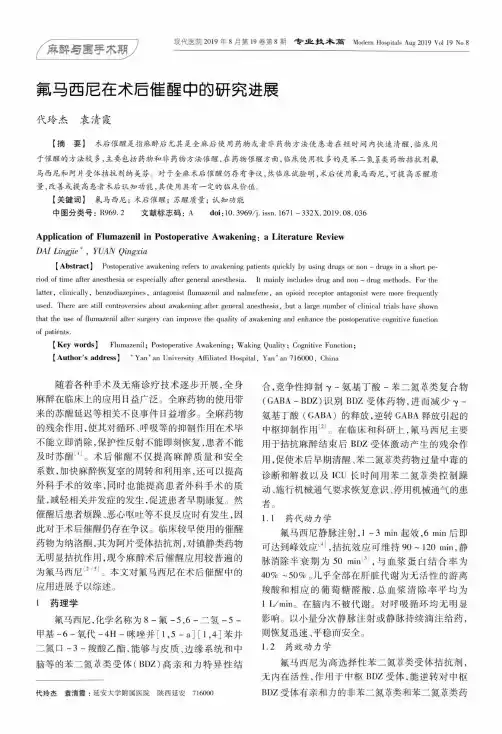
麻醉与围手术期现代医院2019年8月第19卷第8期专"別^,_^^才^篇*Modem Hospitals Aug2019Vol19No8氟马西尼在术后催醒中的研究进展代玲杰袁清霞【摘要】术后催醒是指麻醉后尤其是全麻后使用药物或者非药物方法使患者在短时间内快速清醒,临床用于催醒的方法较多,主要包括药物和非药物方法催醒,在药物催醒方面,临床使用较多的是苯二氮箪类药物拮抗剂氟马西尼和阿片受体拮抗剂纳美芬。
对于全麻术后催醒仍存有争议,然临床试验明,术后使用氟马西尼,可提高苏醒质量,改善或提高患者术后认知功能,其使用具有一定的临床价值。
【关键词】氟马西尼;术后催醒;苏醒质量;认知功能中图分类号:R969.2文献标志码:A doi:10.3969/j.issn.1671-332X.2019.08.036Application of Flumazenil in Postoperative Awakening:a Literature ReviewDAI Lingjie*,YUAN Qingxia[Abstract]Postoperative awakening refers to awakening patients quickly by using drugs or non一drugs in a short period of time after anesthesia or especially after general anesthesia.It mainly includes drug and non-drug methods.For thelatter,clinically,benzodiazepines,antagonist flumazenil and nalmefene,an opioid receptor antagonist were more frequentlyused.There are still controversies about awakening after general anesthesia,but a large number of clinical trials have shownthat the use of flumazenil after surgery can improve the quality of awakening and enhance the postoperative cognitive functionof patients.[Key words]Flumazenil;Postoperative Awakening;Waking Quality;Cognitive Function;【Author's address]*Yan'an University Affiliated I Iospital,Yan*an716000,China随着各种手术及无痛诊疗技术逐步开展,全身麻醉在临床上的应用日益广泛。

氟马西尼治疗阿普唑仑中毒的护理【关键词】阿普唑仑中毒;氟马西尼;护理阿普唑仑是长效苯二氮艹卓类药,临床常用于焦虑不安、顽固性失眠、恐惧以及癫痫的治疗,本品药理作用与地西泮相似,但与地西泮相比其安眠及镇静作用强3~500倍,抗焦虑作用强25~30倍,催眠作用是地西泮的 3.5~11倍[1],本品口服后吸收完全,给药1~2 h后血液浓度即达峰值。
大剂量服用可导致中枢抑制、低血压、深度昏迷和呼吸抑制。
如不及时抢救则可导致严重后遗症甚至死亡。
对阿普唑仑中毒患者抢救,目前已广泛应用其特殊解毒药氟马西尼治疗。
从2007年1月至2008年11月,本科共收治6例阿普唑仑中毒患者均用氟马西尼治疗取得较好效果,将护理体会总结如下。
1 临床资料1.1 一般资料本组6例,男2例,女4例,年龄65~79岁均有多系统基础疾病,如糖尿病、慢性阻塞性肺气肿等。
其中有2例长期服用阿普唑仑药患者,本组患者服阿普唑仑30~50片,服药时间0.5~12 h,入院时表现为昏迷瞳孔缩小、呼吸减慢。
1.2 治疗方法1.2.1 一般处理急诊室立即给予洗胃,同时给予吸氧利尿等对症处理。
入院后遵医嘱立即给予多功能心电监护,大量的输液,应用利尿剂导泻来加速毒物的排泄,同时纠正酸碱平衡,保护肝肾功能并给予抗感染及糖皮质激素治疗。
1.2.2 氟马西尼治疗入院后立即给予氟马西尼0.3 mg静脉注射,60 s内未清醒者即刻再次静脉注射0.3 mg直至清醒,总量不超过3 mg,如清醒后再次发生昏迷,则用输液泵0.1~0.4 mg/h维持[2],直至完全清醒,并密切观察患者神志情况,生命体征变化。
1.3结果本组6例中有2例在服药后2 min内意识明显好转,5 h内意识完全恢复,期于4例出现再次昏迷后给予氟马西尼用输液泵持续静滴,在12~30 h后意识完全恢复。
2 护理2.1 使用氟马西尼的护理2.1.1 氟马西尼是特异性苯二氮艹卓受体,拮抗剂,可竞争阻断苯二氮卓受体,拮抗其中枢神经效应,可迅速逆转其镇静和催眠作用。
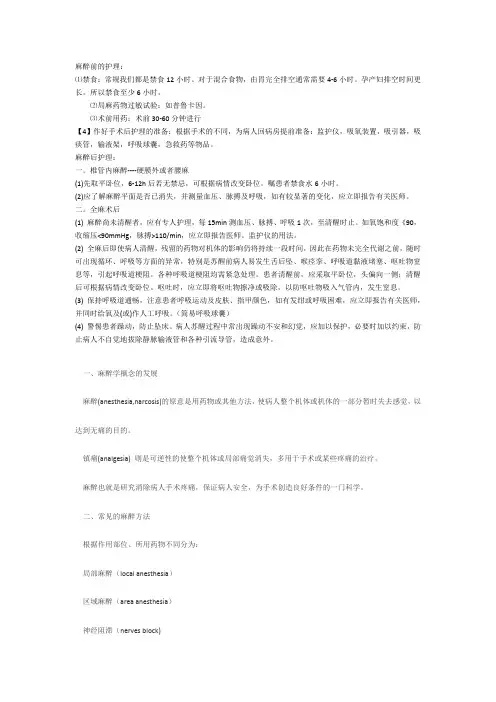
麻醉前的护理:⑴禁食:常规我们都是禁食12小时。
对于混合食物,由胃完全排空通常需要4-6小时。
孕产妇排空时间更长。
所以禁食至少6小时。
⑵局麻药物过敏试验:如普鲁卡因。
⑶术前用药:术前30-60分钟进行【4】作好手术后护理的准备:根据手术的不同,为病人回病房提前准备:监护仪,吸氧装置,吸引器,吸痰管,输液架,呼吸球囊,急救药等物品。
麻醉后护理:一。
椎管内麻醉----硬膜外或者腰麻(1)先取平卧位,6-12h后若无禁忌,可根据病情改变卧位。
嘱患者禁食水6小时。
(2)应了解麻醉平面是否已消失,并测量血压、脉搏及呼吸,如有较显著的变化,应立即报告有关医师。
二。
全麻术后(1) 麻醉尚未清醒者,应有专人护理,每15min测血压、脉搏、呼吸1次,至清醒时止。
如氧饱和度《90,收缩压<90mmHg,脉搏>110/min,应立即报告医师。
监护仪的用法。
(2) 全麻后即使病人清醒,残留的药物对机体的影响仍将持续一段时间,因此在药物未完全代谢之前,随时可出现循环、呼吸等方面的异常,特别是苏醒前病人易发生舌后坠、喉痉挛、呼吸道黏液堵塞、呕吐物窒息等,引起呼吸道梗阻。
各种呼吸道梗阻均需紧急处理。
患者清醒前,应采取平卧位,头偏向一侧;清醒后可根据病情改变卧位。
呕吐时,应立即将呕吐物擦净或吸除,以防呕吐物吸入气管内,发生窒息。
(3) 保持呼吸道通畅,注意患者呼吸运动及皮肤、指甲颜色,如有发绀或呼吸困难,应立即报告有关医师,并同时给氧及(或)作人工呼吸。
(简易呼吸球囊)(4) 警惕患者躁动,防止坠床。
病人苏醒过程中常出现躁动不安和幻觉,应加以保护,必要时加以约束,防止病人不自觉地拔除静脉输液管和各种引流导管,造成意外。
一、麻醉学概念的发展麻醉(anesthesia,narcosis)的原意是用药物或其他方法,使病人整个机体或机体的一部分暂时失去感觉,以达到无痛的目的。
镇痛(analgesia) 则是可逆性的使整个机体或局部痛觉消失,多用于手术或某些疼痛的治疗。
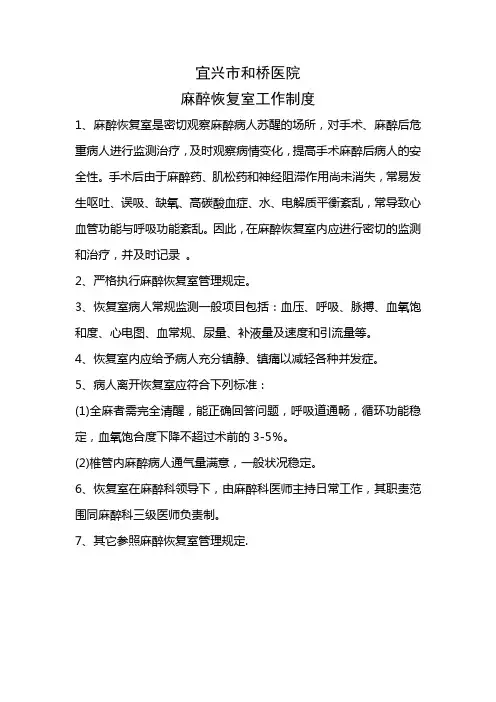
宜兴市和桥医院麻醉恢复室工作制度1、麻醉恢复室是密切观察麻醉病人苏醒的场所,对手术、麻醉后危重病人进行监测治疗,及时观察病情变化,提高手术麻醉后病人的安全性。
手术后由于麻醉药、肌松药和神经阻滞作用尚未消失,常易发生呕吐、误吸、缺氧、高碳酸血症、水、电解质平衡紊乱,常导致心血管功能与呼吸功能紊乱。
因此,在麻醉恢复室内应进行密切的监测和治疗,并及时记录。
2、严格执行麻醉恢复室管理规定。
3、恢复室病人常规监测一般项目包括:血压、呼吸、脉搏、血氧饱和度、心电图、血常规、尿量、补液量及速度和引流量等。
4、恢复室内应给予病人充分镇静、镇痛以减轻各种并发症。
5、病人离开恢复室应符合下列标准:(1)全麻者需完全清醒,能正确回答问题,呼吸道通畅,循环功能稳定,血氧饱合度下降不超过术前的3-5%。
(2)椎管内麻醉病人通气量满意,一般状况稳定。
6、恢复室在麻醉科领导下,由麻醉科医师主持日常工作,其职责范围同麻醉科三级医师负责制。
7、其它参照麻醉恢复室管理规定.麻醉复苏室流程目的:建立恢复室工作流程的标准操作规程,规范研究者的行为,有效保护受试者的生命安全并确保抢救及时、规范。
适用范围:适用于麻醉科操作规程:一、恢复室收治范围1.全身麻醉的病人2.部分区域阻滞麻醉的病人3.麻醉后生命体征不稳定的病人二、病人入室的流程1.当天全身麻醉的手术病人,手术结束后有麻醉医生和手术室洗手护士一同将病人送往恢复室;2.恢复室护士要提前检查好监测仪、药品、急救物品、抢救车等做好接受病人的准备工作;1)接受病人,面罩吸氧,接好脉搏氧饱和度及心电监测仪,测量血压;2)与手术室护士进行面对面的交班,包括麻醉方法、手术名称、使用液体、出入量、引流量、皮肤情况、有无特殊病情、携带物品并及时登记;3)保证病人安全,约束好病人,严防坠床;4)根据医生医嘱对症用药、吸痰,并做好监测及各种记录;5)恢复室的病人每10分钟记录一次,有特殊情况随时记录,30-60分钟后根据恢复室评分标准大于8分可送回病房;三、恢复室Aldret评分标准满分为10分每张床应具备吸氧装置及负压吸引装置,床旁应具备有灭菌的吸痰管、导尿管、吸氧导管或面罩、口咽及鼻咽通气道、胸腔闭式引流瓶、尿引流瓶(袋)、胃肠减压装置等。
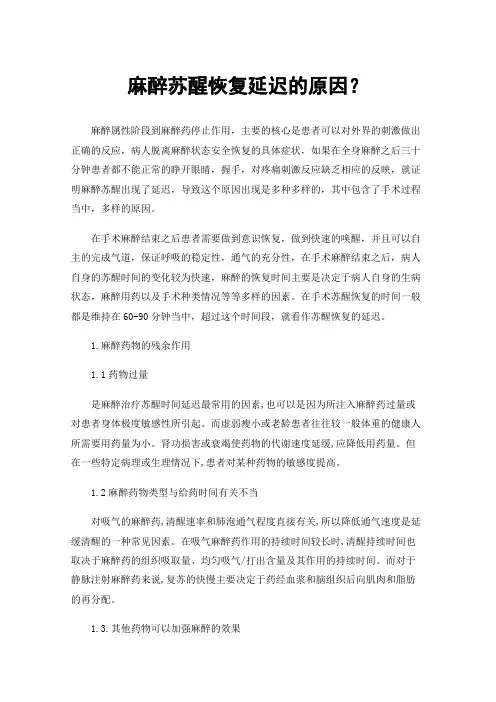
麻醉苏醒恢复延迟的原因?麻醉属性阶段到麻醉药停止作用,主要的核心是患者可以对外界的刺激做出正确的反应,病人脱离麻醉状态安全恢复的具体症状,如果在全身麻醉之后三十分钟患者都不能正常的睁开眼睛,握手,对疼痛刺激反应缺乏相应的反映,就证明麻醉苏醒出现了延迟,导致这个原因出现是多种多样的,其中包含了手术过程当中,多样的原因。
在手术麻醉结束之后患者需要做到意识恢复,做到快速的唤醒,并且可以自主的完成气道,保证呼吸的稳定性,通气的充分性,在手术麻醉结束之后,病人自身的苏醒时间的变化较为快速,麻醉的恢复时间主要是决定于病人自身的生病状态,麻醉用药以及手术种类情况等等多样的因素。
在手术苏醒恢复的时间一般都是维持在60-90分钟当中,超过这个时间段,就看作苏醒恢复的延迟。
1.麻醉药物的残余作用1.1药物过量是麻醉治疗苏醒时间延迟最常用的因素,也可以是因为所注入麻醉药过量或对患者身体极度敏感性所引起。
而虚弱瘦小或老龄患者往往较一般体重的健康人所需要用药量为小。
肾功损害或衰竭使药物的代谢速度延缓,应降低用药量。
但在一些特定病理或生理情况下,患者对某种药物的敏感度提高。
1.2麻醉药物类型与给药时间有关不当对吸气的麻醉药,清醒速率和肺泡通气程度直接有关,所以降低通气速度是延缓清醒的一种常见因素。
在吸气麻醉药作用的持续时间较长时,清醒持续时间也取决于麻醉药的组织吸取量、均匀吸气/打出含量及其作用的持续时间。
而对于静脉注射麻醉药来说,复苏的快慢主要决定于药经血浆和脑组织后向肌肉和脂肪的再分配。
1.3.其他药物可以加强麻醉的效果手术中使用巴比妥类(如鲁米那)或苯二氮卓类(如安定)、在手术中使用乙醇类饮品,或增加对腹腔的麻醉止痛药中枢神经体系抑制,引起苏醒的延缓。
术前及术中使用的西咪替丁和雷尼替丁,可使肝内微粒体对这些药品的氧化作用损害,而延长了镇静药及其它CNS抑制的用药持续时间。
1.4肌松恢复延迟即使病患能力得到充分康复,但由于残余的肌松效应、患者瘫痪仍可以被错误认同为缺乏能力。